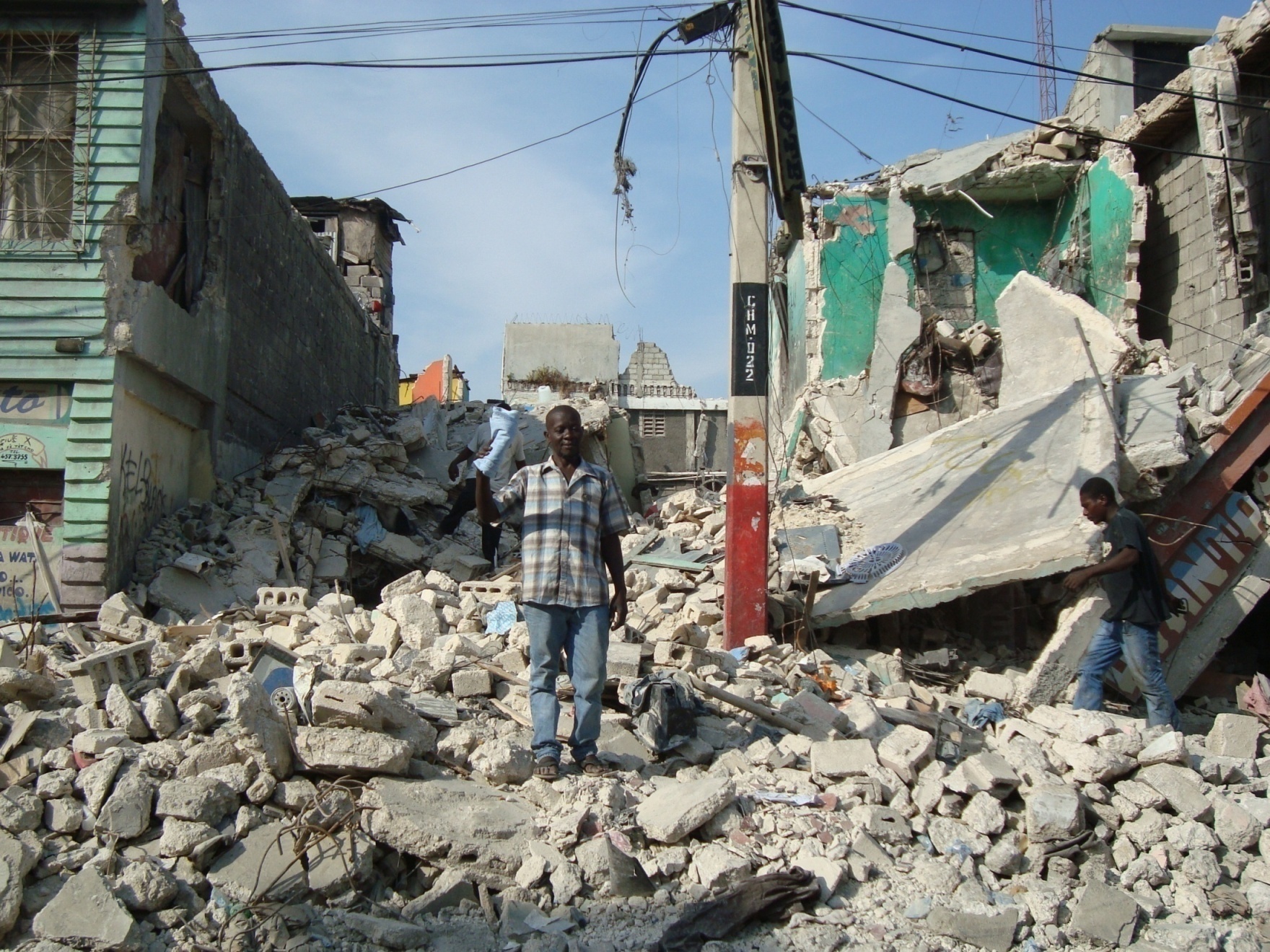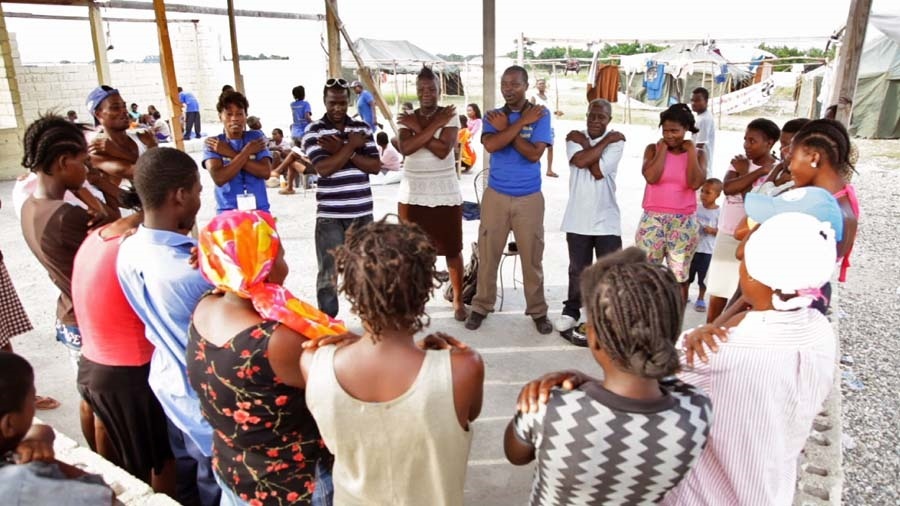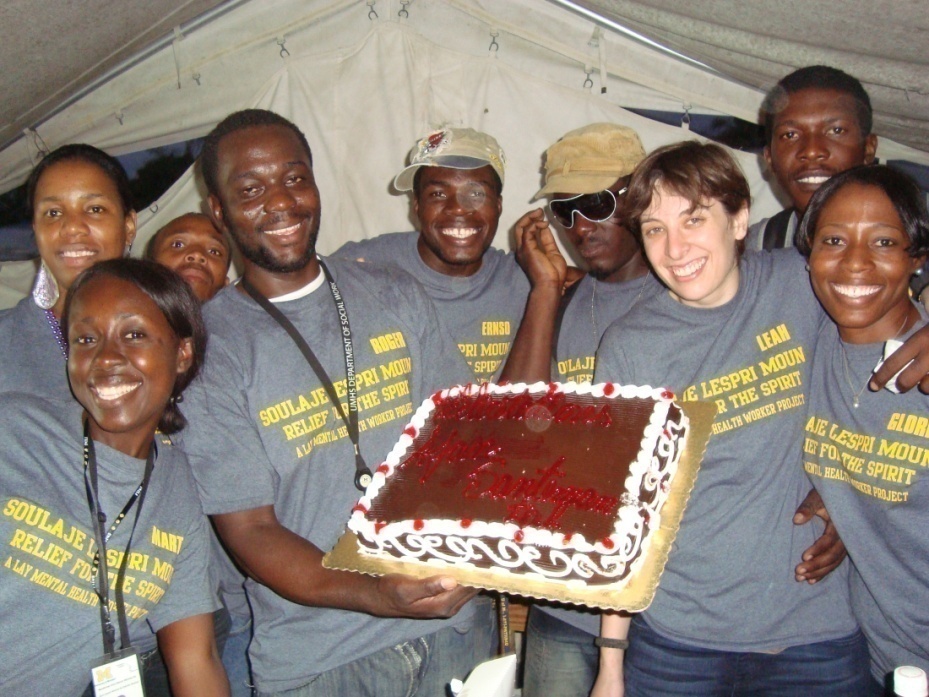You are here
In 2010, Haiti was rocked by what has since been described as the largest urban natural disaster in recorded history, a magnitude 7 earthquake. The quake resulted in 230,000 deaths, 300,600 serious injuries, and 1.5 million displaced individuals in Port-au-Prince alone (United Stages Agency for International Development (USAID)/Office of Foreign Disaster Assistance (OFDA), 2011). Since the 2010 earthquake, a partnership between U.S. mental health professionals & Haiti-based partners has led to the development of a recovery-oriented, lay mental health, group-level intervention called Soulaje Lespri Moun (Haitian-Creole for Relief for the Spirit). This program has been successfully implemented in communities of displaced earthquake survivors across the city of Port-au-Prince, Haiti. The primary aim of this paper is to share some insights on this recovery-oriented and culturally informed approach to disaster mental health response by highlighting key examples from disaster mental health response work in post-earthquake Haiti. What follows is an overview of the SLM intervention, summary of key findings from an evaluation of the program, and discussion of lessons learned as well as possible applications to psychiatric rehabilitation and recovery work here in the U.S.

Understanding Haiti’s Unique Cultural Context
Although an adequate review of the history of Haiti is beyond the scope of this paper, it is worthwhile to outline a few key aspects of Haiti’s unique cultural history to facilitate better understanding of the context within which the SLM intervention was developed and implemented. Located approximately 600 miles south of Florida, Haiti shares the Caribbean island known as the Hispanola with the Dominican Republic and has a population of over ten million people (WHO, 2014). The first black republic in the Western hemisphere, Haiti gained its independence in 1804 after the first successful slave rebellion against its Spanish and French colonial masters (WHO/PAHO, 2010). This aspect of Haiti’s history continues to be a source of great pride for many Haitians.
Haitian culture is most consistent with a collectivist orientation. As such, family constitutes a significant component of this broader concept of the self and is often referred to as the “poto mitan” (center pillar) of Haitian society. Religion is also a critical component of Haitian culture and permeates all major spheres of life including politics, education, health, and morals. The majority of Haitians identify as Christian (roughly 80% Roman Catholic, 16% Protestant). In addition to a Christian faith and religious practices, a significant portion of the population also identifies with the Voodoo (also called “Vodou”) religion, which has its roots in Western African religious traditions (Caribbean Country Management, 2006; Schafer, 2011). Vodou does not only serve a religious function in Haitian culture. Rather, it is also believed to provide medical healing, to serve a preventative function as it relates to health issues, and to provide overall well-being (Augustin, 1999).
Perceptions of Mental Health & Infrastructure/Capacity
Mental illness is generally understood from a spiritual or supernatural paradigm for the majority of Haitians. As such, religious practices have historically been the coping mechanism of choice when Haitians face adverse life events or distress of any kind. Traditional indigenous approaches to treating mental illness remain prevalent in present day Haiti.
Lack of education about and awareness of mental health issues in Haiti contributes greatly to the challenges of dissemination of Western conceptions of mental illness in this cultural context. As is the case in many non-Western, low-income nations, mental health represents a very low priority in the overall health sector in Haiti. At the time of the development and implementation of the SLM program, there were less than 15 psychiatrists and only 2 psychiatric facilities available for inpatient treatment of individuals with severe psychological disturbances in the entire country (Haiti Libre, 2011). In light of this reality, it is not surprising that Haitians have come to rely primarily on traditional practitioners and religious healers when confronted with psychological ailments (WHO/PAHO, 2010).
The current consensus in multicultural psychology is that it is neither appropriate nor effective to simply transport Western-based methods of conceptualizing and treating mental illness to cross-cultural settings (Johnson, Bastien, & Hirschel, 2009). Thus efforts were made to espouse an integrated approach in developing this intervention, emphasizing a merger of Western and local paradigms of healing. As has been demonstrated in other areas of health, it is conceivable that individuals may choose to make use of multiple sources of treatment or to espouse views of illness that combine two or more paradigms (e.g., taking prescribed medications for an illness while also seeking prayer and support from religious leaders for healing).
Soulaje Lespri Moun: A Lay Mental Health Worker Project

In February of 2010, a month after the January 12, 2010 earthquake, a team of researchers from the University of Michigan (UM) traveled to Port-au-Prince to conduct a postdisaster assessment funded by the UN (James, 2010). A doctoral student in the social work and psychology program at UM (Leah James) along with a psychologist from the Ann Arbor Veterans Affairs Healthcare System (Todd Favorite, PhD) traveled with this team to assist with the assessment. In conducting interviews for the UN assessment, James discovered that many of the interviewees described symptoms of PTSD (startle response to noise, hyperarousal, nightmares, sense of the ground trembling under their feet, etc.). To help address the mental health needs of these individuals, James worked with a Haitian translator to create a basic coping protocol to be disseminated at a few camps for internally displaced persons (IDP camps) across Port-au-Prince (James, Favorite, Noel, & Solon, 2010). The Aristide Foundation for Democracy, a Haitian humanitarian organization agreed to support James’ efforts and invited her to conduct similar groups with teachers in mobile schools that had been developed after the earthquake to educate children living in the IDP camps.
Drawing from recovery and empowerment models, the SLM intervention primarily consisted of a culturally adapted psycho-education and skill building protocol, delivered to residents of IDP camps across the city of Port-au-Prince. The primary aim of the SLM project was to facilitate recovery and resiliency processes by drawing from existing cultural assets/strengths that foster increased coping flexibility, social connection, and support among earthquake survivors in Haiti (James, Favorite, Noel, & Solon, 2012). The core components of the SLM program include:
1) disaster and safety education
2) psycho-education on responses to stress and trauma
3) coping skills training (e.g., relaxation), as well as
4) religiosity and meaning making.
Program Evaluations
My primary contribution to the amazing work SLM was doing was to build on the preliminary assessments of the intervention by carrying out a comprehensive and systematic program evaluation. A preliminary assessment of program impact was conducted by the program developer and yielded promising findings, demonstrating a significant reduction in PTSD symptom endorsement as measured by the Harvard Trauma questionnaire (James et. al, 2010). Additionally, a significant difference in number of reported coping strategies was found between SLM participants and a non-participant comparison group, suggesting participation in SLM facilitates expansion of existing coping repertoires (James et. al, 2010).
Using a mixed-methods, community-based participatory research approach, I sought to build on these early assessments by providing information about perceived benefits of the SLM program from the perspectives of community participants, lay mental health workers, and program coordinators. I gathered information about the perceived utility of program components/activities, cultural relevance of the intervention, perceived sustainability, and the extent to which program practices are related to psychosocial outcomes. Suggestions for program improvement were elicited from every respondent.
Key Findings
With the assistance of a team of local research assistants, I surveyed 220 individuals representing both SLM program graduates as well as non-SLM affiliated residents who had lived in the IDP camps for roughly the same amount of time. Participants completed a written questionnaire assessing a range of psychosocial outcomes including religiosity, self-efficacy, sense of belonging, and engagement in valued action, to name a few. Program participation appeared to have a positive impact on many of these outcomes. However, the most notable differences between the SLM and non-SLM study participants were observed in the areas of PTSD symptom endorsement as well as self-reported resilience. Results also revealed statistically significant differences between SLM and non-SLM camp residents on measures of the following outcomes: self and collective efficacy, emotional well-being, social wellbeing, psychological well-being, as well as intrinsic religiosity. Thus, results revealed that graduates of the SLM program tended to report greater resilience, less PTSD symptoms, higher self and collective efficacy, greater intrinsic religiosity, and better overall well-being in terms of emotional, social, and psychological functioning.
Qualitative data were also gathered through one-on-one interviews and focus groups. These data were largely consistent with the quantitative data in providing support for an association between participation in SLM and a range of psychosocial outcomes among camp residents who had completed the program. The most common themes emerging from community participants’ descriptions of gains from participation in SLM reflected resilience and self-efficacy. Other common themes included frequent descriptions of reduced stress, decreased avoidance of stimuli associated with earthquake experiences/memories, and improvement in somatic symptoms such as headaches, sleep problems, and pain.
Staff Perspective of Personal Impact

In approaching this project, I was particularly interested in the impact SLM had on the young men and women who lead the dissemination of this program. Indeed our findings suggest involvement with SLM was associated with positive psychosocial outcomes among the lay mental health workers implementing the intervention. When members of the SLM staff were asked about the personal impact of their involvement with the program, the major themes that emerged included increased coping skills (e.g. “SLM helped me to be less anxious, to be calmer, and to think of solutions for my problems”); better understanding of self/others (e.g., “SLM helped me to better understand people and showed me how to better get along with others”); sense of patriotism or pride in being able to help their country (e.g., “Because of SLM, I have more love for my fellow countrymen”); and a greater sense of purpose (e.g., “SLM re-oriented my life and gave me the opportunity to contribute to society”). Many of these themes are captured in the response of one staff member who stated:
“After such a catastrophe, in which I was traumatized myself, I wanted to help but could not see a path to be involved in the country’s recovery. SLM provided me the means to bring help to my people, my country.”
Discussion
Overall, the SLM intervention demonstrated promise and capacity to predict a number of psychosocial outcomes associated with positive recovery from a natural disaster or other traumatic experiences. Results suggest the program is perceived as highly beneficial by participants and implementers alike. In-depth interviews and focus groups, combined with a quantitative survey, provided rich and detailed data, showing improvements in psychosocial well-being among program participants and staff. Results also provided a unique window into the experiences of the primary beneficiaries of the SLM intervention. Ultimately, findings provide important direction for program refinement and suggest this community-based intervention may be a model for recovery-oriented and culturally-informed disaster mental health work in the context of large-scale, international emergencies.
An important factor in the SLM program’s impact on participants and staff appears to be the extent to which the program is perceived as being culturally relevant. Qualitative analyses yielded findings suggesting that cultural relevance of the intervention was regarded as a notable strength by both participants and staff. The SLM program’s commitment to recovery is reflected in its emphasis on empowering local people and has proven to be a key contributor to its success. This commitment to using the cultural and experiential expertise of survivors and lay people resulted in benefits consistent with those often observed from the integration of peer support specialists in psychiatric rehabilitation here in the U.S.
Conclusion
Although the experience of psychological distress is a normal response to such traumatic events as Haiti’s 2010 earthquake, distress is one of many possible responses. Indeed people also possess a remarkable capacity for self-recovery and resilience in the face of disasters (IASC, 2010). Drawing heavily from recovery and empowerment models, much care was taken in the development of the SLM program to provide a culturally compatible model for engaging survivors in their own recovery process.
Findings from the current investigation suggest the SLM intervention is regarded as largely successful (by participants and staff alike) in meetings its objective of promoting recovery and resilience through empowerment and engagement in prosocial action. The results of this study lend support to the notion that recovery and resilience can be fostered in the face of great tragedy. Findings provide a glimpse into long-term recovery process in Haiti’s unique cultural context, demonstrating that engaging survivors in their own process of recovery appears to offer great therapeutic value and fosters a sense of empowerment by allowing survivors to take an active role in their own healing.
In the words of a lay mental health worker: “In a moment/time when people thought their only hope would come from international organizations, SLM taught us that we had something to offer and that we could be the best help that our countrymen needed.”

References
Augustin J. Le Vodou libérateur. Et si le Vodou était une valeur! Montreal: Tanboula; 1999.
Caribbean Country Management Unit. (2006). Social Resilience and State Fragility in Haiti: A Country Social Analysis: World Bank.
Haiti Libre (2011). Haiti – sante: Moins de 20 psychiatres pour plus de 10 million de personnes. Retrieved October 10, 2011 from http://www.haitilibre.com/article-3988-haiti-santemoins-de-20-psychiatre...
Interagency Standing Committee (IASC) Mental Health and Psychosocial Support (MHPSS) Reference Group. (2010). Haiti Earthquake Emergency Response. Retrieved September 15, 2010 from http://www.who.int/hac/crises/hti/haiti_guidance_note_mhpss.pdf
James, L. E. (2010, March 29). Not too soon for mental health care in Port-au-Prince. Retrieved October 2, 2011 from http://www.huffingtonpost.com/leah-james/not-too-soon-formental-h_b_513863.html
James, L. E., Favorite, T., Noel, J. R., & Solon, J. J. (2010). Development of a lay mental health worker project in post-earthquake Haiti: Challenges of post-disaster intervention in cultural context. Manuscript submitted for publication.
James, L. E., Favorite, T., Noel, J. R., & Solon, J. J. (2012). Challenges of postdisaster intervention in cultural context: The implementation of a lay mental health worker project in postearthquake Haiti. International Perspectives in Psychology: Research, Practice, Consultation, 1(2), 110–126.
Johnson, L. R., Bastien, G., & Hirschel, M. J. (2009). Psychotherapy in a culturally diverse world. In S. Eshun & R. A. R. Gurung (Eds.), Culture and Mental Health (pp.115-148). United Kingdon: Wiley-Blackwell.
Schafer, A. (2011). Spirituality and mental health in humanitarian contexts: An exploration based on World Vision’s Haiti earthquake response. Intervention, 8(2), 121-130.
United Stages Agency for International Development (USAID)/Office of Foreign Disaster Assistance (OFDA), (2011). Haiti – Earthquake: Fact Sheet #11. Retrieved March 6, 2011 from http://www.usaid.gov/our_work/humanitarian_assistance/disaster_assistanc...
United States Department of Veterans Affairs. (2010, June 30). Disaster Mental Health Treatment. Retrieved November 27, 2012 from http://www.ptsd.va.gov/public/pages/disaster_mental_health_treatment.asp
World Health Organization (2014). Retrieved from http://www.who.int/countries/hti/en/
WHO/PAHO (2010). Culture and Mental health in Haiti: A literature review. Geneva: World Health Organisation.



